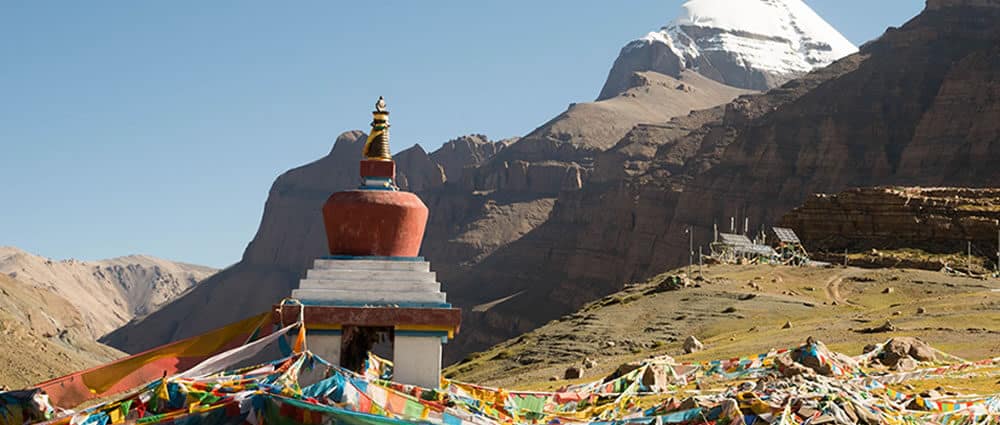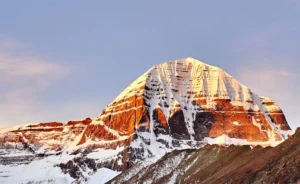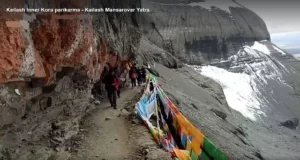
Mount Kailash and Mansoravar Yatra From Nepal
The holy Mountain, Mount Kailash, and the sacred lake, Mansoravar are located in Tibet, and routes from Uttarkhand are connected in India. Pilgrimages from India can reach Mount Kailash through the Lipulekh pass in Kuman. Mount Kailash has an altitude of 6,714m above sea level. Mount Kailash lies near to Lake Mansarovar and Lake Rakshastal. The sources of four major Asian rivers lie close to this mountain and the two lakes. The Kailash Range is said to be 30 million years old, formed during the early stages of the formation of the Himalayan Mountains, and is also considered the holy residence of Lord Shiva and Goddess Parvati. Mount Kailash is also known as the center of the universe in the Hindu Purans and Buddhist texts, Astpaad in Jain texts, and Yungdruk GU Tseng in the Bonpa tradition.
Mansarovar Lake is a large freshwater lake situated in Tibet. The circumstances of Mansoravar Lake, which is about 30km from Mount Kailash, are approximately 90km. During winter time, the lake freezes completely and melts only during the spring season. The Mansarovar Lake is an inseparable part of Kailash. Every year pilgrims from different parts and tourists across the world visit Mansoravar to experience the beauty and devoutness of the place. The legends say that the lake was first created in the mind of Lord Brahma and so is named Mansoravar also the lake is a bathing place for gods during Brahma Muhurat. Mansoravar, as the name suggests, is a combination of two Sanskrit words: Manas means “mind” and “intellect” and Sarovar means “lake”. Holy lake Mansoravar is compared with the mind of lords which is calm as water and as strong as tranquil as a mountain.

Best time to visit Mount Kailash Mansoravar Tour
Kailash Mansoravar yatra During May- June and September- October
May till October is meant to be the best time for traveling to Kailash Mansarovar. The ice starts melting and makes the temperature soothing for trekking, sightseeing, and enjoying the beauty of the place with the high visibility and stunningly beautiful views accompanied by comfortable temperatures of 0 to 33 degrees Celsius. Also, during the night time wind pressure and temperature drop down rapidly to – degrees Celsius. After mid-October, the weather might be freezing cold and snowfall may start. During the snow time, it will be difficult to drive and to get water around. Also, the guest houses are closed till April.
The temperature during these months is not too cold to cause danger during the trekking. The supply of travel equipment and food is sufficient during this time as both shops in Darchen town and the supply points along the way will basically be open.
Mount Kailash Mansarovar Yatra Tentative Temperature during May- October
| Months | Max Temperature | Min Temperature |
| May | 7 degree Celsius | -6 degree Celsius |
| June | 11.3 degree Celsius | -1 degree Celsius |
| September | 8.8 degree Celsius | -2.8 degree Celsius |
| October | 3.7 degree Celsius | -9.8 degree Celsius |
Kailash Mansoravar yatra During November – April
November to April is meant to be the coldest and most snowy time. No visitors visit Kailash Mansoravar during these months, as during this time the place is dominated by wind and icy coldness. A lot of snow covers the circumambulation route, and the route becomes very poor and becomes very difficult to walk on the road. Due to the decreasing temperature, one might get altitude sickness. So this is not a suitable time to go for Kailash Mansarovar Yatra.
Kailash Mansarovar Temperature during November- April
| Months | Max Temperature | Min Temperature |
| November | -1.4 degree Celsius | -14.4 degree Celsius |
| December | -4 degree Celsius | -16.8 degree Celsius |
| January | -6 degree Celsius | -18 degree Celsius |
| February | -5.1 degree Celsius | -16.6 degree Celsius |
| March | -2.2 degree Celsius | -12.8 degree Celsius |
| April | 3.1 degree Celsius | -9.6 degree Celsius |
Kailash Mansoravar Yatra during & Saga Dawa Festival
Saga Dawa festival, a Tibetan Buddhist festival is also conducted during the month of April. During this time local Tibetans go one circle around Mt. Kailash in the year of the horse, so as to get the blessings 13 times more than that usual and the wish they made will be more likely to come true. Shakyamuni also pours into this area, as this day is the birthday of Lord Buddha. Most of the days at Kailash Mansoravar during this time are sunny with deep blue skies and very fresh air for the Tibet tour. Though it could be a bit crowded during these months, however, the visit to Kailash Mansarovar is itself the most auspicious place to get the blessing at any time.
Kailash Mansarovar Yatra during Horse Year or Goat Year
Going to Kailash Mansarovar Yatra and taking blessings during Horse year means having 12 times more powerful than in another year. The horse year is celebrated once in 12 years. Previously the Horse Year was in 2014 and the Goat year was in 2015 so now the next horse year will be in 2026 and the Goat year will be in 2027. Many Pilgrims from different places come to Kailash Mansarovar to thoroughly eliminate their evil and sins and liberate their spirits. This is just a tradition of Tibetan people, you can visit Kailash Mansoravar at any time. As long as you visit Kailash Mansarovar, you will get blessings.
Major Attractions of Kailash Mansoravar Yatra
Lake Mansoravar
Lake Mansarovar lies on the foot of the divine Mount Kailash where people take a holy dip to relieve themselves from their sins. Mansoravar is known as the highest freshwater lake in the world holding sacred importance, situated at an altitude of 4950 meters above sea level. This lake is believed to change color while it is blue near the shores, it changes to an emerald green color towards the center. During the moonlight, the lake becomes absolutely beautiful and surreal.
Mount Kailash
Mount Kailash has an altitude of 6,714m above sea level. Mount Kailash lies near Lake Mansarovar and Lake Rakshastal. Mount Kailash is known as the adobe of Lord Shiva and goddess Parvati, which also holds religious significance for people of other religious including Sikhs, Jains, Buddhists, and Bons. No one has climbed the holy peaks of Mount Kailash as it is restricted in the Hindu religion. However, devotees go here to do their circumambulation and seek the blessings of Lord Shiva.
Visit to the Inner Kora- Nandi Parikrama
The Inner Kora is a path leading directly into the south face of Mount Kailash which is one of the most challenging sacred walks. Walk to the Inner Parikrama needs some mountaineering experience and equipment. The Inner Parikrama involves around 34km walking journey including Asthapath, Nandi Parvat, Atmalingam, Saptarishi cave, and Rakshas Lingam.
Rakshas Taal- A Ghost Lake
Rakshas Taal lies just beside Mansarovar Lake. Rakshas Taal is known as Lang-Tso, which means the dark lake of Poison. It carries salty, slightly bitter water. Rakshas Taal is one of the beautiful lakes but it says that the lake figure is like a sleeping human body. According to Mythology, King Ravan got negative energy and fell down with Goddess Sita after taking a bath in the Lake. Since then no one go to the lake and touch the water in this Rakshas Taal.
Saptarishi Caves
The Saptarishi caves are located at a great elevation of approximately 6000 meters above sea level. This cave is one of the popular tourist places to visit during the Kailash Mansarovar Yatra. These caves consist of the thirteen chortans which are well managed as well as maintained by the Gengta Monastery situated in the Inner Kora Parikrama. These caves are counted amongst the most difficult treks experienced at the time of Inner Kora.

Tibetan Culture
Kailash Mansarovar Yatra is rich in unique Tibetan Bon Culture, experiencing and understanding the Tibetan lifestyle and culture. You can also get a glimpse of several monasteries, religious buildings, local people`s houses, hotels, guest houses, hotels, and shops. The best part of the journey is recognizing Tibetan art, culture, music, festival, local Tibetan language, and many more.
Permit and Visa Requirements for Kailash Mansarovar Yatra
Every foreigner who wishes to go for a Kailash Mansarovar Yatra requires a valid China Visa and Tibet Travel Permit. Also, you will need other regional travel permits and entry tickets to enter Mt Kailash for Scared Walk Kora. Our company, Well Nepal Travel and Tours takes a responsibility for the required Visa and Permits, which will be valid till Kailash Mansoravar Journey. For that, we need your passport copies, which you can send us through mail to apply for a Tibetan travel permit. Before entering to Tibet, visitors should obtain both a Group Tourist Visa and a Travel Permit Tibet, which is issued by the Chinese Embassy. Permit and Visa get issued on a strict basis i.e. the entire group should enter and exit together.
The Visa and permit must be applied for 45 days before the Kailash Yatra date which will be issued 7-10 days before the Yatra. After the permit is issued, next you should apply for the Kailash Yatra Visa which takes around 4-5 working days.
Hotels and Foods in Tibet
Every time when you travel, food is the main important thing. Tibet has different types of meals to eat as Tibet restaurants and hotels in the city area have offered cuisine of food to travelers. Tibetan cuisine is widely influenced by neighboring dishes like Chinese, Nepalese and Indian dishes. So you will not have any food problems while traveling to Kailash Mansarovar Yatra. Hotels and accommodation can be easily available from 5 stars to budgetary hotels, guest houses, and lodges to the homestay.
